The flag of Vanuatu is more than a mere piece of fabric; it’s a powerful emblem of national pride and collective identity. Through its distinct design and colors, it weaves a narrative of Vanuatu’s diverse culture, cherished traditions, and the collective vision of its people for a prosperous future.
Vanuatu Flag
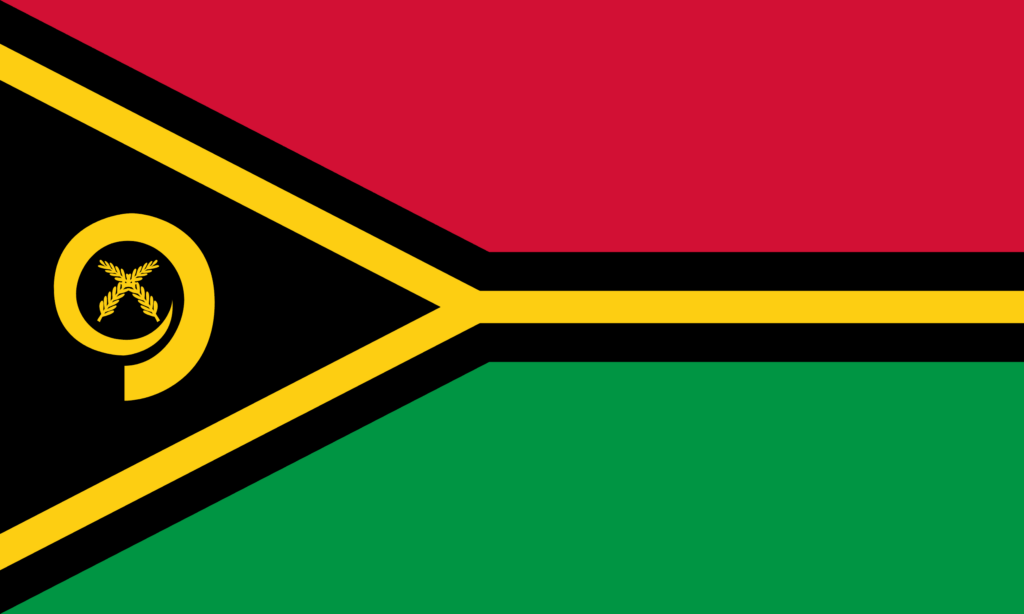
The flag of Vanuatu stands as a vivid emblem that encapsulates the nation’s character and values. Dominated by a distinctive Y-shaped pattern in yellow and black, the flag is adorned with four primary colors: red, green, black, and yellow.
At its hoist side, a symbolic boar’s tusk circles two crosses, namely fern fronds. Each color and symbol on the flag is imbued with meaning, narrating tales of the island nation’s origins, rich culture, and the aspirations of its people. Adopted in 1980, this flag profoundly represents Vanuatu’s pride and identity.
Vanuatu Flag: Color Palette
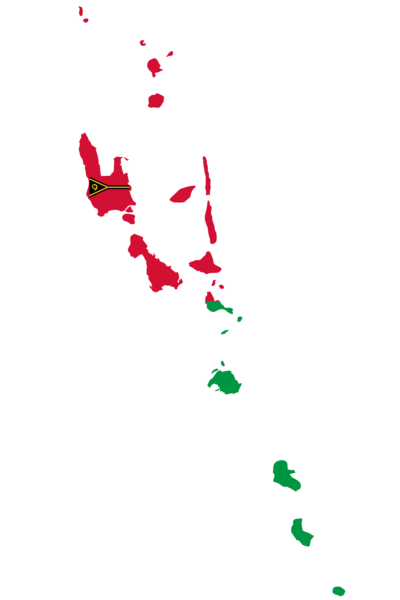
Vanuatu Flag Emoji: 🇻🇺
The color palette of Vanuatu’s flag is both vibrant and meaningful, carefully chosen to encapsulate critical aspects of the country’s essence. While harmonious in the collective visual, each hue carries its weight and significance that will be delved into in the subsequent sections.
Meaning of Each Color
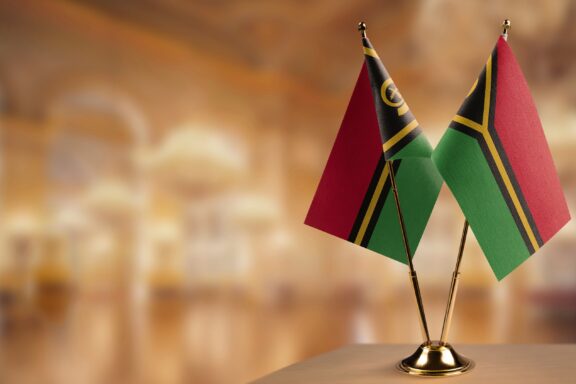
Black
Historically, the color black in Vanuatu’s flag celebrates the Melanesian roots of most of its inhabitants, as well as traditions and stories that often emphasize the strength and resilience of their ancestors.
The prominent black in the flag is a testament to these tales and the enduring spirit of the Melanesian people in Vanuatu.
Red
Red has profound roots in the narratives of many nations, often symbolizing the bloodshed in their quest for freedom. In Vanuatu, it’s no different.
This hue commemorates the sacrifices made by its people for sovereignty and progress. Furthermore, culturally, red is often seen as a vibrant and passionate color, reflecting the zest and vitality of the Vanuatuan community.
Green
With its sprawling landscapes and lush vegetation, Vanuatu has green as a natural choice for its flag. Historically, the islands have relied on their fertile lands for agriculture and sustenance.
The green is a nod to this agricultural backdrop and the inhabitants’ deep respect for their land and environment. It embodies growth, prosperity, and the country’s commitment to preserving its natural beauty for future generations.
Yellow
Yellow, often associated with sunshine, resonates with Vanuatu’s tropical and sun-kissed geography. Beyond the evident connection to its climate, yellow also signifies hope and optimism.
Throughout their history, the people of Vanuatu have faced various challenges, and this color stands as a beacon, reminding them of brighter days and the promise of a radiant future.
Vanuatu Coat of Arms
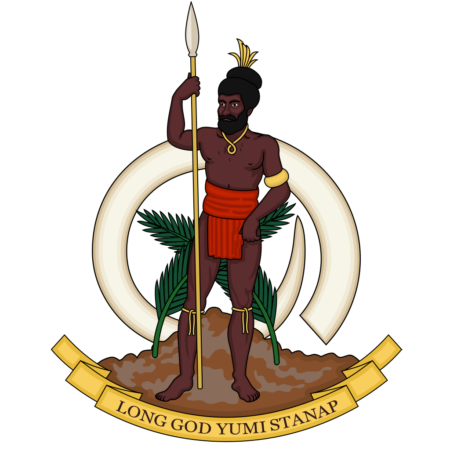
Vanuatu’s coat of arms is a symbolic representation of the nation’s unique identity and Melanesian heritage. It comprises a warrior’s headgear above two crossed namele leaves (a type of fern endemic to Vanuatu, scientifically known as “Cyclosorus interrupts.”) set within a circular border.
A scroll beneath this emblem carries the national motto: “Long God yumi stanap” (In God we stand). The elements within the coat of arms emphasize Vanuatu’s cultural values, traditional beliefs, and the nation’s spiritual foundation.
Together, they serve as a visual testament to Vanuatu’s rich history and enduring traditions.
Historical Evolution and the Meaning Behind Changes
Vanuatu’s flag has its roots in the country’s journey to independence and its desire to establish a distinct national individuality.
Before independence, the New Hebrides, as Vanuatu was formerly known, was jointly managed by France and the UK in a unique arrangement called the Condominium. During this time, the islands didn’t have a singular flag. Instead, the British and French flags flew side by side, representing the dual colonial rule.
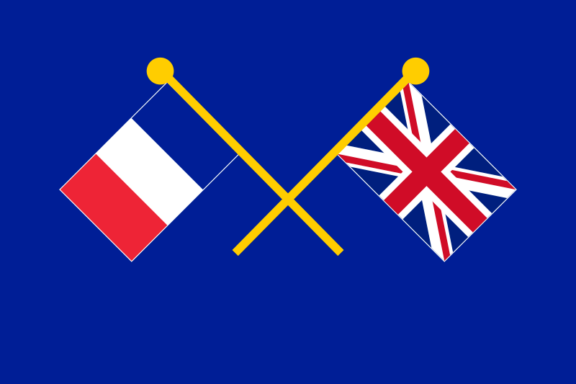
As Vanuatu approached independence in the late 20th century, there was a keen sense of crafting a symbol that resonated with its Melanesian roots. This led to adopting the current flag in 1980, the same year Vanuatu became independent.
The selection of the flag’s colors and symbols was not random. Each element was chosen with intent. The Y-shaped pattern in yellow and black represents the country’s geographical layout, as Vanuatu consists of a Y-shaped chain of islands.
The colors red, black, yellow, and green were chosen for their aesthetic appeal and deep-rooted significance to the nation’s past, environment, and people.
The emblem of the boar’s tusk and namele fern fronds further strengthened this connection, emphasizing the island’s rich traditions and hopes for peace and prosperity.
Overall Symbolic Meaning of the Flag
The flag of Vanuatu is a tapestry of tales, values, and history woven together in a harmonious blend of colors and symbols. Individually, each element has its distinct significance, but when viewed collectively, they narrate a unified story of Vanuatu as a nation.
Similar Flags to Vanuatu
Flags often carry shared symbols due to common histories or universal themes. Let’s explore countries with flags that resonate with elements of Vanuatu’s design.
South Africa
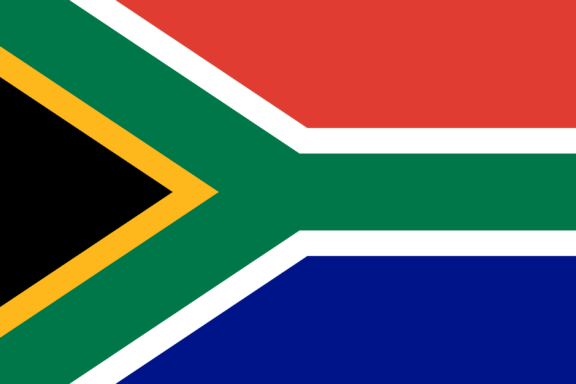
South Africa’s flag features a unique Y-shaped design that starts on the flag’s hoist side and envelops the flag. It combines red, blue, green, black, and yellow.
Both flags use a distinct Y-shaped design, albeit oriented differently. They also employ the colors black, green, and yellow, often associated with African and Melanesian heritages.
Mozambique
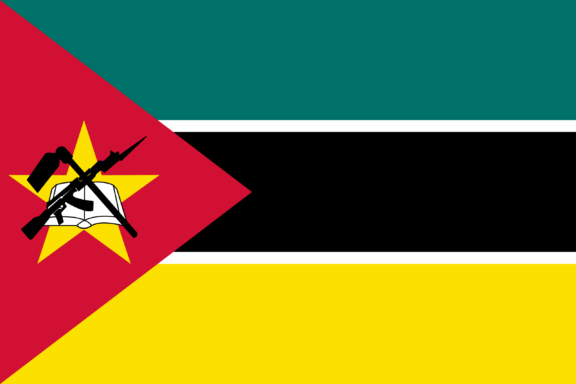
Green, black, and yellow horizontal stripes characterize Mozambique’s flag. Overlapping these stripes near the hoist side is a red triangle, upon which sits a white emblem containing an AK-47 crossed with a hoe above an open book.
The colors green, black, and yellow appear in both flags, indicative of shared African and Melanesian color symbolism. Furthermore, the presence of potent emblems on both flags speaks to the importance of national symbols in representing history and aspirations.
São Tomé and Príncipe
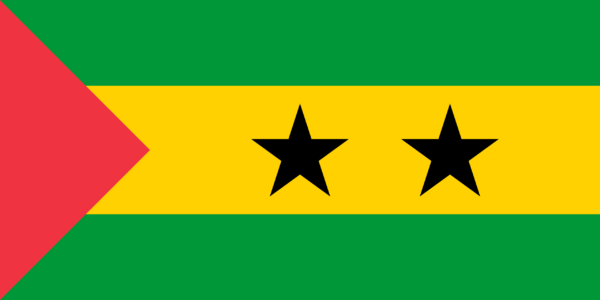
The flag of São Tomé and Príncipe consists of three horizontal bands of green, yellow, and green. Two black stars are centered on the yellow band.
Both flags use a combination of red, green, and yellow, standard colors and distinct symbols, such as the black stars on São Tomé and Príncipe’s flag and the emblem on Vanuatu’s flag, which further draw a parallel between the two.
Guinea-Bissau
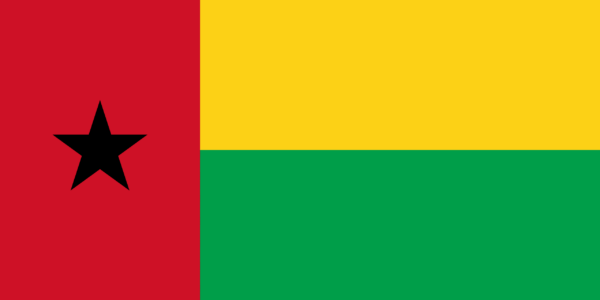
The flag of Guinea-Bissau showcases two horizontal bands of yellow over green, with a red vertical stripe on the hoist side. At the center of the yellow band is a black star.
Both flags’ use of red, green, and black draws visual similarities. Additionally, incorporating symbols such as Vanuatu’s emblem and Guinea-Bissau’s star underscores the significance of representing the nations and their history through powerful symbols.
Conclusion
While Vanuatu’s flag stands distinct in its Melanesian narrative, its shared elements with other global flags spotlight the intertwined tales and universal themes that weave our world together.
Through such symbols, we glimpse the bonds that connect diverse nations and are reminded of the shared stories that transcend boundaries.
Image Sources and Copyright Information
- Two Vanuatu Flags on Stand: © BUTENKOV ALEKSEI/Shutterstock